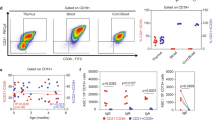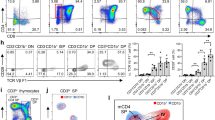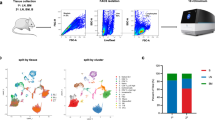Abstract
Most thymocytes are either immature or functionally deficient and express a series of lymphocyte cell-surface antigen markers designated Lyt 1, Lyt 2 and Lyt 3 (refs 1,2) which have been useful in distinguishing functional subsets of T cells3,4. In contrast, a small population of cortisone-resistant thymocytes (CRT), confined to the thymic medulla after acute corticosteroid treatment are functionally more mature. These cells, like peripheral T cells, have restricted expression of Lyt antigens and mostly are either Lyt 1 or Lyt 123 cells3–5. It has thus been assumed that all thymocytes initially are Lyt 1+, 2+, 3+ and by differentiation lose either Lyt 1 or Lyt 2, 3 to result in Lyt 1+(23−) and Lyt (1−)23+ cells6–8. Using immunofluorescence (IF) and flow microfluorometry (FMF) analyses to detect Lyt antigen expression quantitatively without the requirement for cell lysis, we have now re-examined the expression of Lyt 1, 2 and 3 antigens on murine fetal thymocytes from 14 to 19 days of gestation and on normal thymocytes from birth to 2–3-monthold adults. These studies demonstrate that cells with the Lyt l+23− phenotype first appear in the thymus several days before Lyt 123+ thymocytes are detected, and suggest either a micro-environmental or site-specific influence for phenotypic differentiation and/or two independent, pre-committed lineages.
This is a preview of subscription content, access via your institution
Access options
Subscribe to this journal
Receive 51 print issues and online access
$199.00 per year
only $3.90 per issue
Buy this article
- Purchase on Springer Link
- Instant access to full article PDF
Prices may be subject to local taxes which are calculated during checkout
Similar content being viewed by others
References
Boyse, E. A., Miyazawa, M., Aoki, T. & Old, L. J. Proc. R. Soc. B170, 175–193 (1968).
Boyse, E. A., Itakura, K., Stockert, E., Iritani, C. A. & Miura, M. Transplantation 11, 351–353 (1971).
Kisielow, P. et al. Nature 253, 219–220 (1975).
Cantor, H. & Boyse, E. A. J. exp. Med. 141, 1376–1389 (1975).
Mathieson, B. J., Sharrow, S. O., Campbell, P. S. & Asofsky, R. Nature 277, 478–480 (1979).
Cantor, H. & Boyse, E. A. Immun. Rev. 33, 105–124 (1977).
Shen, F. W., McDougal, J. S., Bard, J. & Cort, S. P. J. exp. Med. 151, 566–572 (1980).
Kamarck, M. E. & Gottlieb, P. D. J. Immun. 119, 407–415 (1977).
Shen, F.-W., Boyse, E. A. & Cantor, H. Immunogenetics 2, 591–595 (1975).
Betel, I., Mathieson, B. J., Sharrow, S. O. & Asofsky, R. J. Immun. 124, 2209–2217 (1980).
Mandel, T. Z. Zellforsch. 106, 498–515 (1970).
Mandel, T. & Russell, P. J. Immunology 21, 659–674 (1971).
Scollay, R., Kochen, J., Butcher, E. & Weissman, I. Nature 276, 79–80 (1978).
Owen, J. J. T. & Ritter, M. A. J. exp. Med. 129, 431–437 (1969).
Shortman, K. & Jackson, H. Cell. Immun. 12, 230–246 (1974).
Mosier, D. E. J. Immun. 112, 305–310 (1974).
LeDouarin, N. M. & Jotereau, F. V. J. exp. Med. 142, 17–40 (1975).
Jotereau, F. V. & Houssaint, E. in Developmental Immunobiology (eds Soloman, J. B. & Horton, J. D.) 123–130 (Biomedical Press, Amsterdam, 1977).
Huber, B., Cantor, H., Shen, F.-W. & Boyse, E. A. J. exp. Med. 144, 1128–1133 (1976).
Holtzer, H. in Stem Cells and Tissue Homeostasis (eds Lord, B. I., Potten, C. S. & Cole, R. J.) 1–27 (Cambridge University Press, 1978).
Weissman, I. L. J. exp. Med. 126, 291–304 (1967).
Zinkernagel, R. Immun. Rev. 42, 224–270 (1978).
Stutman, O. Immun. Rev. 42, 138–184 (1978).
Leckband, E. & Boyse, E. A. Science 172, 1258–1260 (1971).
Kisielow, P., Draber, P. & Wysocka, M. Eur. J. Immun. 9, 1023–1025 (1979).
Mathieson, B. J., Campbell, P.S., Potter, M. & Asofsky, R. J. exp. Med. 147, 1267–1279 (1978).
Loken, M. R. & Herzenberg, L. A. Ann. N.Y. Acad. Sci. 254, 163–171 (1975).
Miller, M. H., Powell, J. I., Sharrow, S. O. & Schultz, A. R. Rev. scient. Instrum. 49, 1137–1142 (1978).
Author information
Authors and Affiliations
Rights and permissions
About this article
Cite this article
Mathieson, B., Sharrow, S., Rosenberg, Y. et al. Lyt 1+23− cells appear in the thymus before Lyt 123+ cells. Nature 289, 179–181 (1981). https://doi.org/10.1038/289179a0
Received:
Accepted:
Issue Date:
DOI: https://doi.org/10.1038/289179a0
This article is cited by
-
T cell ontogeny: Extrathymic and intrathymic development of embryonic lymphohemopoietic stem cells
Immunologic Research (1987)
-
Selective immortalization of murine macrophages from fresh bone marrow by a raf/myc recombinant murine retrovirus
Nature (1985)
-
Expression of interleukin-2 receptors as a differentiation marker on intrathymic stem cells
Nature (1985)
-
Expression and function of interleukin-2 receptors on immature thymocytes
Nature (1985)
-
Intrathymic differentiation: Introductory remarks on problems and approaches
Survey of Immunologic Research (1985)
Comments
By submitting a comment you agree to abide by our Terms and Community Guidelines. If you find something abusive or that does not comply with our terms or guidelines please flag it as inappropriate.



